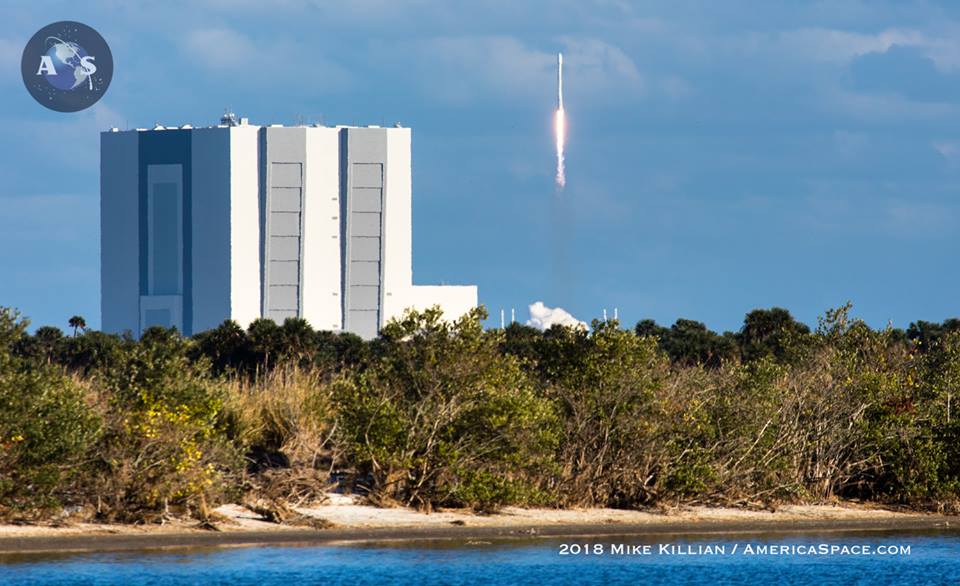
Six hours shy of six full decades since the launch of America’s first man-made “moon”, a U.S.-built rocket has smoothly delivered SES-16/GovSat-1, one of the world’s largest and most powerful communications satellites into geostationary orbit, some 22,300 miles (35,900 km) above the Home Planet. SpaceX’s Upgraded Falcon 9 roared aloft at 4:25 p.m. EST Wednesday, 31 January, from Space Launch Complex (SLC)-40 at Cape Canaveral Air Force Station, Fla. And as the flare of its nine Merlin 1D+ engines shook the ground, watchers at the Air Force Space & Missile Museum—formerly Launch Complex (LC)-26A—looked upward in wonder.
Situated 8.2 miles (13.1 km) south of SLC-40, theirs was the exact birthplace of America’s journey to the stars. For on 31 January 1958, LC-26A saw a Juno I booster thunder into the night and deliver Explorer 1 into Medium Earth Orbit (MEO) on a voyage of scientific discovery, political and technological triumph…and great relief for the American people.
Sixty years later, the relief for SpaceX was palpable, as it returned to a regular launch cadence, three weeks after the much-publicized furore over the fate of its classified Zuma payload and only days since the long-delayed Static Fire Test of the Falcon Heavy. Tonight’s mission was the 48th outing by a member of the Falcon 9 rocket family since June 2010 and the Hawthorne, Calif.-headquartered launch services organization confidently expects to fly three more times in the next two weeks. With the Falcon Heavy slated to rise from Pad 39A on 6 February, followed by Spain’s Paz radar-imaging platform from Vandenberg Air Force Base, Calif., on the 10th and the Hispasat 30W-6 communications satellite from the Cape on the 14th, this promises to be the largest number of launches in such a short period ever achieved by SpaceX.
VIDEO CREDIT: Alan Walters / AmericaSpace
Built by Orbital ATK, the SES-16/GovSat-1 payload is flying as part of a joint venture between the Government of Luxembourg and leading worldwide satellite operator SES. It hosts a multi-mission architecture for military and defense users, together with wider governmental and institutional customers. Rising from Space Launch Complex (SLC)-40 at Cape Canaveral Air Force Station, Fla., at 4:25 p.m. EST, right on the opening of Wednesday’s 141-minute “window”, the flight marks the fifth SES bird to be delivered to orbit by SpaceX and only the second outing of Orbital ATK’s state-of-the-art GeoStar-3 satellite bus.
Today’s mission follows on the heels of a hugely successful 2017, which saw the Hawthorne, Calif.-based organization launch no fewer than 18 missions, inaugurating historic Pad 39A for SpaceX operations, staging two classified voyages for the National Reconnaissance Office (NRO), lofting a record-breaking four cargo ships to the International Space Station (ISS) and demonstrating the reusability of both its Dragon and Upgraded Falcon 9 hardware. All told, 2017 saw 54 major payloads transported to orbit by SpaceX.
A bright 2018 was tempered on 7 January, when Zuma was reportedly lost during ascent. SpaceX was quick to stress that its vehicle performed nominally, as January closed out with Static Fire Tests of both the GovSat-1 booster and the maiden Falcon Heavy. The coming days are expected to see as many as four launches from the East and West Coasts, with today’s GovSat-1 to be followed by the Falcon Heavy test flight NET 6 February, then a pair of commercial missions on the 10th and 14th. Successful completion of this quartet will set SpaceX firmly on the road to its goal of an approximately 50-percent uplift on last year’s launch rate.
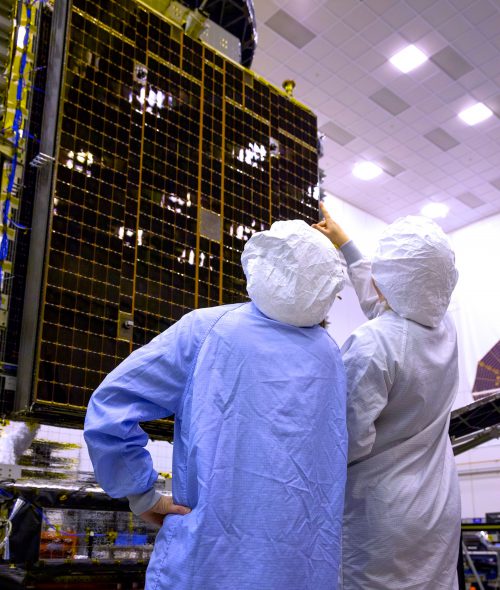
GovSat-1 is also known as “SES-16” and represents the fifth SES satellite to be launched atop a Falcon 9, after SpaceX’s very first mission to geostationary altitude (SES-8), way back in December 2013. That payload was based on Orbital ATK’s small-sized and highly versatile GeoStar-2 bus, which has enjoyed more than 30 successful flights since July 2002. The upgraded GeoStar-3 draws many of its heritage features from its predecessor, ranging from its electrical generation capabilities, its structure and its hybrid propulsion system. However, it boasts the added benefits of larger solar arrays, enhanced power output via its Ultra-Triple-Junction gallium arsenide solar cells and increased-capacity lithium-ion batteries. Moreover, the low-mass GeoStar-3 bus enables it to handle communications payloads of up to 1,760 pounds (800 kg), whilst providing end-of-mission power of up to eight kilowatts—almost 40 percent greater than the GeoStar-2—and dissipating up to 4.8 kilowatts of heat, thus allowing it to host high-powered satellites.
Introduced by Orbital Sciences Corp. in March 2014, it was noted that GeoStar-3’s greater fuel efficiencies could support a design lifetime of 15-18 years in the punishing geostationary environment, some 22,300 miles (35,900 km) above the Home Planet. It was stressed at the time that its hybrid propulsion system—which utilizes conventional chemical propellants for orbit-raising operations, together with heritage pulsed plasma or electric thrusters to maneuver from near-geostationary into stable-geostationary orbit—would allow GeoStar-3 to attain its required altitude within days, rather than months. In July 2014, the first order was received for the new bus. Abu Dhabi-headquartered YahSat and London-based Avanti Communications signed contracts with Orbital to build their Al Yah-3 and Hylas-4 communications satellites.
Six months later, in January 2015, SES and the Luxembourg Government announced their intent to create a new company, with the intent that each would invest 50 million Euros ($62.2 million), in addition to a 125-million-Euro ($155.4 million) loan from a consortium of Luxembourgish banks to finance the procurement and launch of SES-16/GovSat-1. In mid-February, the newly-formed LuxGovSat S.A. company officially ordered the satellite from the newly renamed Orbital ATK, only days after Orbital Sciences Corp. merged with elements of Alliant TechSystems, Inc. Under the terms of the contract, SES-16/GovSat-1 would launch in the second quarter of 2017, with an expectation from SES Chief Technology Officer Martin Halliwell that it would “ensure flexibility for the ever-changing missions of governments and institutions in the security, defense and civil arenas”.
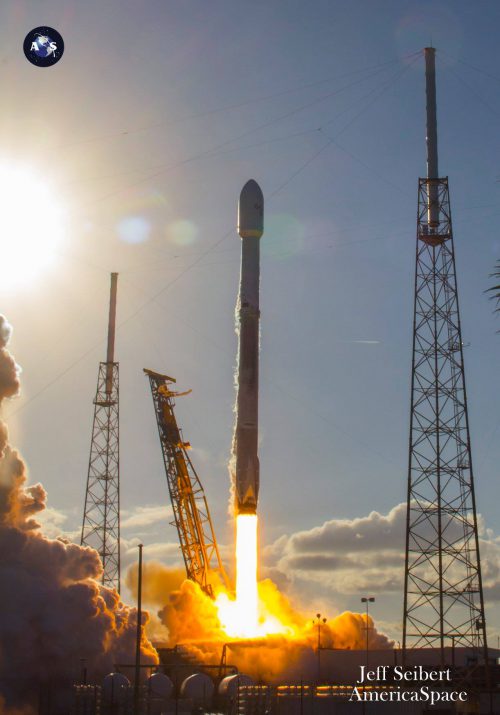
By the end of February 2015, SES had reached agreement with SpaceX to launch both the SES-16/GovSat-1 payload and another mission, SES-14, aboard Falcon 9 vehicles. In parallel developments, the European Arianespace organization had signed a deal to launch the SES-12 satellite to orbit, with all three targeted to be flown by the end of 2017. Plans changed last summer, when SES announced that it had switched launch providers. SES-12 would now fly atop an Upgraded Falcon 9 and SES-14 would ride an Ariane 5. “The swap of launches,” it was explained, “will enable SES to improve service quality and continuity for its customers.” SES-14 launched atop an Ariane 5 on 25 January, co-manifested with Al Yah-3, which became the first GeoStar-3 to fly.
Unfortunately, a booster telemetry glitch left SES-14 in an off-nominal orbit. The satellite remains in good health, and is expected to reach its intended orbit about a month later than planned, but the fate of Al Yah-3 remains unclear. “Based on data from initial communications, I can report that Al Yah-3 is in orbit, healthy and responding to commands from our mission operations team,” said Frank Culbertson, president of Orbital ATK’s Space Systems Group. “We will continue to work closely with our customer, YahSat, to meet their mission objectives and remain confident that we will deliver a fully operational satellite to the planned orbit.”
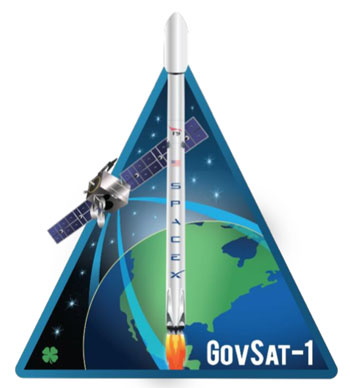
Consequently, SES-16/GovSat-1 would become the first GeoStar-3 bus to successfully enter its operational orbit. The 9,325-pound (4,230 kg) satellite was delivered to Cape Canaveral earlier this month for final checkout, fueling and integration with the bullet-like payload fairing of the Upgraded Falcon 9. It was revealed by SpaceX that the Upgraded Falcon 9 for GovSat-1 would include a re-used first-stage—specifically, the core previously employed for the NROL-76 launch in May 2017—but that no recovery attempt would be made, due to high-energy mission requirements. The booster was transported to SLC-40 on 25 January and elevated to the vertical, marking the first occasion that a pair of Falcon rockets had stood upright at the same time on separate launch pads.
A mere 48 hours after the Falcon Heavy static fire, the nine Merlin 1D+ first-stages of the SES-16/GovSat-1 booster roared to life, burning for about nine seconds and shutting down, precisely as planned. “Static fire test of Falcon 9 complete,” SpaceX tweeted, shortly afterwards, before confirming 30 January as the date for the opening launch attempt. However, the weather outlook was not expected to be good, with a 40-percent likelihood of acceptable conditions at T-0, improving to 90-percent favorable for the backup date on Wednesday, 31 January. In its L-1 briefing on Monday morning, the 45th Weather Squadron at Patrick Air Force Base reinforced the gloomy outlook. “Skies will be partly cloudy on launch day, with northerly winds gusting to 30 mph (48 km/h),” it was explained. “Winds will diminish through the launch window.” This was expected to produce an increased 60-percent likelihood of acceptable conditions, later in the 141-minute window.
The primary concern for Tuesday’s launch attempt was a violation of the Liftoff Winds Rule. “Liftoff Winds are dependent on the launch complex and the rocket’s fairing,” the 45th Space Wing at Patrick Air Force Base explained, in response to an AmericaSpace enquiry on Tuesday. “Our 60 percent of violation forecast is based off northerly winds at 30 mph (48 km/h) at the beginning of the window. As the launch window progresses, winds are forecasted to shift to the northeast and slow down, due to local weather effects. This information, determined by our 45th Space Wing Weather Squadron, is provided to SpaceX, who considers liftoff winds among many other factors in their decision to launch.”
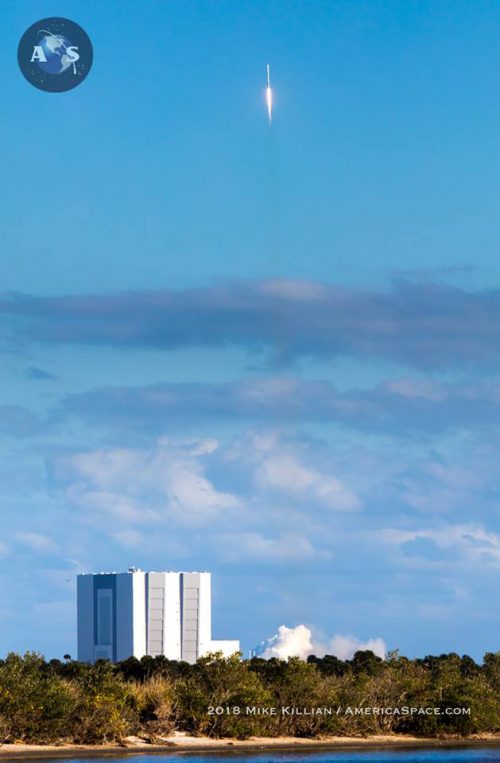
Notwithstanding the pessimistic outlook, SpaceX pressed into the opening launch attempt, against gloomy skies and windy conditions. By 2:45 p.m. EST, it was revealed that T-0 had been recycled to no earlier than 5:30 p.m., approximately halfway through Tuesday’s 141-minute window, in the hope that the winds would subside. However, it was not to be. At 3:16 p.m., a 24-hour scrub was declared. “Standing down for today,” SpaceX tweeted. “Team is going to replace a second-stage sensor. Next available launch opportunity is tomorrow, January 31.”
Moving into Wednesday’s attempt, conditions were greatly improved, with fluffy white clouds against a crystal-clear blue sky. “Winds continue dropping off overnight, allowing maximum cooling and a cold Wednesday morning, with lows in the 40s Fahrenheit,” the 45th Weather Squadron noted. “Temperatures rebound quickly as winds turn easterly, bringing in some scattered low-level cloudiness. Mid-level moisture also increases slightly, creating a very small threat of thick cloud layers. Maximum upper-level winds will be from the west at 100 knots near 40,000 feet.”
Engineers set to work loading the booster with 793,670 pounds (360,000 kg) of liquid oxygen and 341,700 pounds (155,000 kg) of a highly refined form of rocket-grade kerosene, known as “RP-1”. Following first- and second-stage RP-1 tanking, the effort to load oxidizer aboard the Upgraded Falcon 9 began shortly after 3:40 p.m. EST, about 35 minutes before T-0.
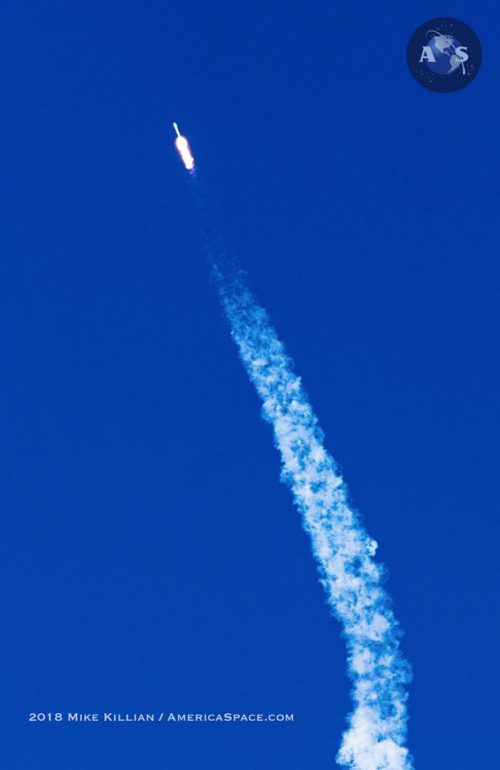
Passing T-10 minutes, the terminal autosequencer was initiated and the nine Merlin 1D+ engines were chilled, ahead of the ignition sequence. During this critical period, SES-16/GovSat-1 was transitioned to from external Ground Support Equipment (GSE) to Internal Power, running off its on-board batteries until such time that its electricity-generating solar arrays could be unfurled in orbit. At T-2 minutes, the Air Force Range Safety Officer declared that all ground-side assets were “Go for Launch” and the 230-foot-tall (70-meter) Upgraded Falcon 9 went into “Startup” a minute later, as its systems took primary control of the remainder of the countdown. The Niagara water-deluge system at SLC-40 also began flooding the pad surface with 30,000 gallons (113,500 liters) of water to reduce the acoustic energy at the instant of liftoff.
Three seconds before T-0, the nine Merlins rumbled to life, quickly ramping up to a combined thrust of 1.5 million pounds (680,000 kg). Computers checked the health of the engines, then issued the liftoff command, with the Upgraded Falcon 9 departing SLC-40 at 4:25 p.m.l EST. It followed a characteristically perfect ascent trajectory, with the first-stage providing the muscle for 2.5 minutes, before shutting down and separating. “Main engine cutoff and stage separation confirmed,” SpaceX tweeted at 4:28 p.m. “Second stage engine burn underway.”
This left the second stage—equipped with a singular Merlin 1D+ Vacuum engine, capable of 210,000 pounds (95,250 kg) of thrust—with the task of executing a pair of “burns” to deliver SES-16/GovSat-1 to Geostationary Transfer Orbit (GTO). The first burn ran for almost six minutes, before the engine shut down and the stack coasted for 18 minutes, prior to the second burn. The latter ran for only 70 seconds, establishing the proper conditions for payload deployment. “Final second stage engine cutoff nominal,” tweeted SpaceX at 4:53 p.m. EST.
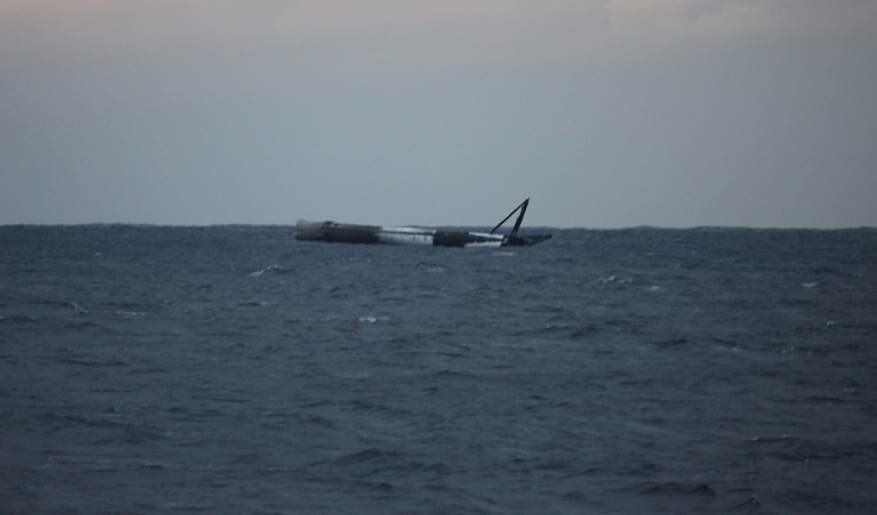
SES-16/GovSat-1 was released shortly afterwards, at 4:57 p.m., only 32 minutes after departing the Cape. When fully operational at 21.5 degrees East longitude, the satellite is expected to provide secure, reliable and accessible communications services for governments and address connectivity demands for defense and international security applications. SES-16/GovSat-1 offers 68 transponder-equivalent units of 36 MHz and houses a “multi-mission” payload with a secure X-band element for government usage and a military Ka-band component for data-intensive services. The satellite’s high-powered, steerable spot-beams offers wide-area coverage for secure communications, high-throughput and mobility operations.
As fore the rocket’s flight-proved first stage, surprisingly it appears in tact after splashdown in the Atlantic. “This rocket was meant to test very high retrothrust landing in water so it didn’t hurt the droneship, but amazingly it has survived,” tweeted Elon Musk. “We will try to tow it back to shore.”
The Luxembourg Government presently commits about 0.4 percent of its GDP to NATO—far short of the 2-percent required by the organization for defense—and has pre-committed a significant amount of capacity aboard SES-16/GovSat-1 in support of its obligations. In November 2016, GovSat revealed a long-term commercial Satellite Communications (SATCOM) contract to support the operational phase of NATO’s Alliance Ground Surveillance (AGS) capability. Under the terms of the contract, the service included the delivery of satellite capacity in commercial Ku-band, as well as associated capacity management support to provide the required command and control and sensor data communications between the NATO Global Hawk Unmanned Aerial Vehicles (UAVs) over the AGS operational area.
The satellite’s fully steerable spot-beams can directly focused coverage on key mission areas, with specific focus upon intelligence, surveillance and reconnaissance, as well as communications on the move. Its “footprint” extends across the entirety of continental Europe, together with Africa and the Middle East, plus maritime coverage of the Mediterranean and Baltic Seas and the Atlantic and Indian Oceans. In the case of Mediterranean observations, it is anticipated that SES-16/GovSat-1 will play a key role in enabling communications for European Border Surveillance.
FOLLOW AmericaSpace on Facebook!
.






It seems the survival of the booster is a surprise bonus.
https://twitter.com/elonmusk/status/958847818583584768/photo/1
Definitely surprising. I wonder if this surprise is going to generate useful procedures down the road. I’m not predicting it will or won’t. It has been noted elsewhere many times that useful new ideas are less likely to be Eureka, than That’s Odd.
This is incredible progress that SpaceX is making in Booster recovery…Now if we just has Lockheed and Boeing…nevermind